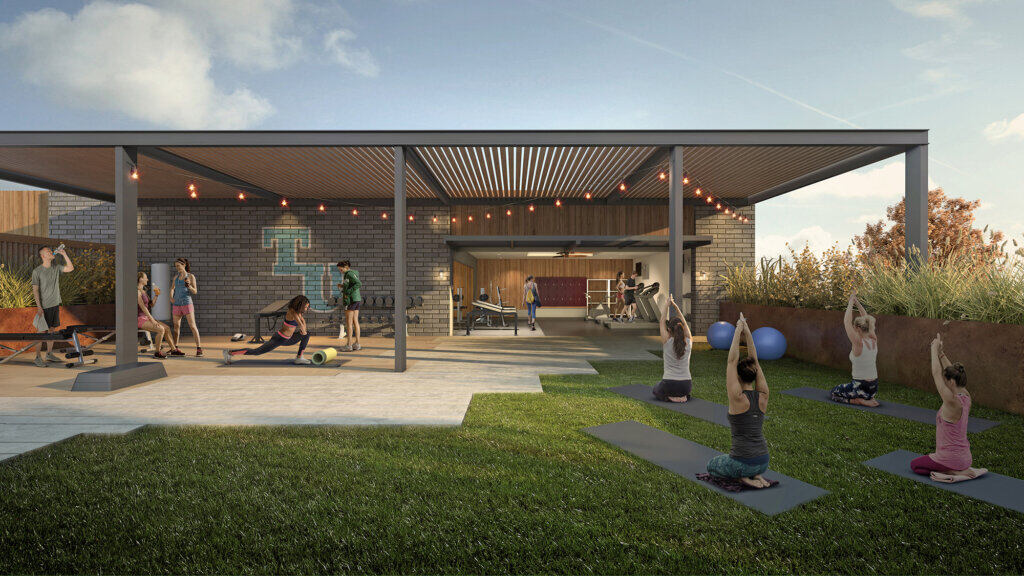
As the great philosophers Mick Jagger and Keith Richards once said, “You can’t always get what you want. But if you try sometimes, well, you might find you get what you need.” For the last few decades, student housing developments have seemingly grown bigger and bigger — a shift aligning with what many college students say that they want. The appeal is understandable; apartment-style units with large, private bedrooms and bathrooms and luxurious, resort-like amenities have gained prominence in contemporary student housing design. Student housing plays an important role in the experience of college students, but while these features may sound desirable to recent high school graduates, when the cost of rent starts accumulating and students find themselves struggling to settle into college life, it’s time to consider if what students want is what they really need.
Mental Health and Wellbeing
The 2023 class of graduating seniors faces new trials unique to their generation as they head off to college. These students spent a significant segment of their high school careers watching video classes from their bedrooms, wearing masks throughout the school day, and making the most of minimal extracurricular offerings. They missed out on critical social development during a pivotal time in their lives and are now playing catch-up. This comes on the heels of an ongoing decline in mental health for American teens. With the rise of social media, college-obsessed parenting, and the weight of an increasingly stressful world (Thompson, Derek. “Why American Teens Are So Sad.” The Atlantic, April 11, 2022.), young people are struggling with their mental health at rates never seen before. A 2023 report by the Centers for Disease Control and Prevention (CDC) found that an average 42% of young people experience persistent feelings of sadness and hopelessness (in 2021, up from 37% in 2019). The report also outlined an increase in suicidal thoughts, most commonly experienced by women, multiracial, and LGBTQ+ students. Seventy-five percent of all lifetime cases of mental illness begin by age 24 (National Alliance on Mental Illness). From eating disorders to depression, anxiety to post-traumatic stress disorder, mental illness affects more than one in five adults in the United States (CDC).
Financial Pressure
Current college students are also accumulating debt at a higher rate than ever before. In addition to the increasing cost of higher education, construction costs and housing shortages lead to higher living costs for students. Some student housing developers address this challenge, shortsightedly, by maximizing densities. Reducing natural light and cramming as many students into their buildings as possible, these strategies only solve for housing cost and fail to address the needs of the whole student.
As a national design firm with a resume including over 14,000 beds of student housing, we at KTGY studied these alarming trends and propose that the next generation of student housing should specifically address the mental health and wellness of its student residents. Combined with professional medical support, student housing design can integrate strategies that encourage students to thrive during their college years. Most student housing designs from the last two decades include long corridors with anonymous units lining either side. Students are expected to eat, sleep, and study without leaving their unit. Amenity spaces are often large and concentrated in a single location, making spontaneous interactions less likely. Are these the best ways to design healthy spaces for young people?
Creating and Reinforcing Community
Research by a British evolutionary anthropologist, Robin Dunbar, shows that groups beyond 150 individuals lead to an inability among group members to “function effectively in social relationships.” Ideally, groups of 50 or fewer friends, including 15 good friends and five close friends, support healthy relationships. Student housing developments often house over one thousand students, making it very difficult to form connections. As an alternative to orienting units off a maze of double-loaded corridors, units can be divided into housing pods of 30 or 40 students, each with its own shared lounge, encouraging students to form strong friendships and connections. As financial strain is a common stressor for college students, each pod includes a different rooming type, accommodating a range of financial needs, personality types and social priorities. Some students may benefit from connecting with roommates, while others find constant social interaction unbearable. Students then have a range of options, from dorm-style living suites, to private sleeping spaces with shared bathrooms and kitchens, to small, private studio units, and may choose to change to a different pod type as their needs change. Smaller, distributed amenity spaces, in proximity to each of the housing pods, further connect students and encourage them to spend time with a manageable number of familiar faces.
Quality Rest and Intentional Study Spaces
A 2021 report by the CDC outlined the strong correlation between sleep and mental health. Within the study, those who averaged less than six hours of sleep per night were nearly two and a half times more likely to experience mental health issues than those averaging above six hours. In student housing situations, incompatible roommate habits disrupt the length and quality of rest, leading to both physical and mental health challenges. Sleeping nooks with sliding privacy doors help create a visual and acoustic separation for students sharing the same space. The sliding doors can then be opened as the student chooses, allowing in natural daylight. Intentionally small sleeping spaces focus their purpose on sleeping or relaxing and discourage activities like gaming and studying. Instead, study spaces and gaming rooms are located in shared areas. As the brain creates associations between different experiences, the stress and stimulation linked to studying negatively affect the brain’s ability to rest. Removing desks from the sleeping rooms and relocating them to shared spaces within the pods creates distance between spaces for productivity and spaces for relaxation, increasing the effectiveness of both. Each housing pod can include enough study spaces for every student in the pod, embracing the mobility of modern study habits.
Encouraging an Active and Healthy Lifestyle
While some students resist spending time outside of their room, design strategies can maximize their experiences when students leave their room for required tasks such as gathering the mail or washing laundry. Lounge spaces, game rooms, and outdoor amenities in proximity to spaces for required tasks encourage students to linger and socialize while completing their chores. Small fitness rooms dispersed in each building makes it easier for students to maintain a fitness routine. Rather than a large party-pool, a stream-like water feature can wind through outdoor spaces, creating a pleasant auditory experience. A central quad connects the pods together, forming a network of walking paths and a lush, landscaped experience, encouraging students to spend time outdoors.
Within KTGY’s Research and Development Studio, we synthesized these strategies into a design concept for student housing that supports mental health and wellness. This conceptual student housing design, Thrive Hall, begins with a KTGY-designed student housing development and reimagines a new approach centered on mental wellness while achieving the same number of beds and amount of amenity space as a traditional development. The Thrive Hall concept proves that these considerations for supporting mental health can be incorporated into student housing without compromising density or project budgets and emphasizes that student housing must be cognizant of the costs conveyed to student renters.
Today’s college students face unprecedented challenges. As designers of student housing, when we look to the future of student life, we have not just the opportunity, but the responsibility to consider how design best supports the needs of students. Creating community, encouraging healthy habits, and supporting mental wellness will set students up for success not only during their college careers, but well into the future. The college experience is more than essays and tests; it is a life experience that welcomes young people into adulthood. Student housing is the backdrop for many of those life experiences and the future of student housing design should appreciate this important role.

—Marissa Kasdan is director of design with KTGY. In her role as director of design for the R+D studio at KTGY, Marissa Kasdan leads the creation and execution of research and development projects, exploring new and emerging ideas related to building design and technology.

